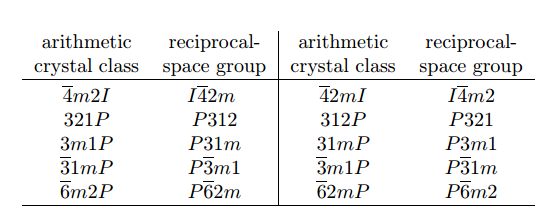 Help
Help
Bilbao Crystallographic Server
 Help Help
|

From its definition it follows that the reciprocal-space group (G)* is isomorphic to a symmorphic space group G0 (for symmorphic space groups, cf. ITA, Section 8.1.6). Space groups of the same type define the same type of reciprocal-space group (G)*. In addition, as (G)* does not depend on the column parts of the space-group operations, all space groups of the same arithmetic crystal class determine the same type of (G)* (Wintgen, 1941) (for definition and symbols of arithmetic crystal classes, see Section 8.2.3 of ITA). For about 2/3 of the space groups, (G)* and G belong to the same arithmetic crystal class, i. e given the space group G, its reciprocal-space group (G)* is isomorphic to the symmorphic group G0 related to G. However, there are a number of cases when the arithmetic crystal classes of G and (G)* are different. For example, if the lattice symbol of G is F or I, then the lattice symbol of (G)* is I or F. (The tetragonal space groups form an exception from this rule; for these the symbol I persists). The rest of the exceptions are listed in the table:

Uni-arm description
Two k-vectors of a Wyckoff position are called uni-arm if one can be obtained from the other by parameter variation. The description of k-vectors stars of a Wyckoff position is called uni-arm if the k-vectors representing these stars are uni-arm. Frequently, in order to achieve uni-arm description, it is necessary to transform k-vectors to equivalent ones. In addition, to enable a uni-arm description, symmetry lines outside the asymmetric unit may be selected as orbit representatives. Such a segment of a line is called a flagpole. In analogy to the flagpoles, symmetry planes outside the asymmetric unit may be selected as orbit representatives. Such a segment of a plane is called a wing.
|
Bilbao Crystallographic Server www.cryst.ehu.es |
For comments, please mail to administrador.bcs@ehu.es |